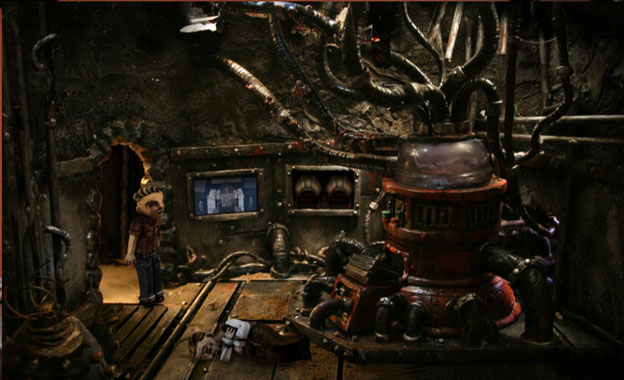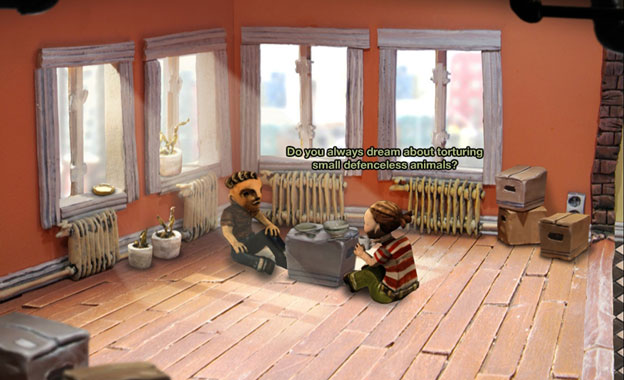Victor Neff Goes To Dream Land
Let’s face it. Despite Roger Ebert’s opinion to the contrary, video games can be art too. There are just too many examples of deeply moving and thought-provoking titles to deny this fact any longer. One example on this ever-expanding list is a project by small Swedish developer Cockroach Inc. titled The Dream Machine.
The Dream Machine tells the story of Victor Neff, a man who has just moved into a brand new apartment with his pregnant girlfriend Alicia. However, after their first night here, they begin to realize there’s something incredibly “off” about this place. They both have strange dreams, the landlord is kind of creepy, and the previous tenant has left a mysterious note of warning. Though the dreams could just be a result of the stress of moving day and the note could have easily been a prank, things just keep getting weirder, prompting Victor to investigate. Now, I don’t want to spoil anything here, so I’ll just say that what Victor finds is a bit unsettling.

The very first thing players will notice about the Dream Machine is its unique art style. In fact, the game was nominated for an award in “Excellence in Visual Arts” at the 14th Annual Independent Games Festival. And that’s because Cockroach Inc. has taken a different approach to game design: they decided to make all the set pieces and characters out of cardboard and clay. No polygons invited. This coats the whole affair in a layer of imperfection; it’s flawed and raw, but in a way that gives it a deeper level of humanity. In fact, the guys at Cockroach have even admitted to intentionally leaving fingerprints on some of the objects in the game to accomplish this very thing.
Now, I wouldn’t necessarily call the visuals beautiful; perhaps beautifully ugly would be a better term. Victor’s world is a flawed one where things are always just a tad bit out of place. The handmade sets of The Dream Machine put players into the proper mindset right away, prodding them to try to figure out what exactly it is that feels “off” here.

And that’s what makes the game so intriguing. The story is an admittedly adult tale of new beginnings, represented by both the move to a new apartment and the new life Victor’s girlfriend carries in her womb. The Dream Machine’s plot draws on basic human fears, but not in a Silent Hill sort of way (though parallel worlds do take center stage in this story.) Instead, the game plays on real-life day-to-day fears that most people will encounter at some point in their time on this planet. Moving to a new place can be scary. Having a child on the way can be scary. And finding out that your landlord has a video camera in your bedroom is extremely scary.
There is a little bit of music in the game, and it’s appropriately dark. Some of it is plain ominous, and other bits of it seem to accentuate certain aspects of the story. Mr. Morton’s discordant jazz music fits his personality quite well, for example. Sound effects are minimal, but that sort of goes with the point-and-click territory. All in all, the audio is incredibly stripped down, but almost eerily effective.

The gameplay here is simple; The Dream Machine adheres to the age-old point-and-click adventure game formula, leading players through a series of puzzles before showing them each piece of the story. Thankfully, puzzles in the Dream Machine are incredibly clever. Too many point-and-click games are full of incomprehensible puzzles with completely nonsensical answers. The Dream Machine, however, has some incredibly well-thought-out solutions that will ultimately make sense. That’s not to say they’re easy; quite the contrary. Some of these solutions won’t present themselves until you’ve spent a good deal of time just pondering over the things you’ve seen so far. But when you finally do stumble upon a solution, it’s immensely satisfying.
The Dream Machine is pretty brief. There are five chapters planned, and at the time of this writing, three of those chapters are available to play. If you’re good at puzzle-solving, you should be able to get through all three chapters in a few hours. Now, it’s unfortunate that you probably won’t be tempted to play this game over and over, but the feeling the game leaves you with lingers for quite some time. In fact, you might find yourself pondering this strange little title days later.
Every character has an intriguing personality, and getting to explore physical representations of their dreams brings an added layer of mystery to each one. (Why does every person in Alicia’s dream look exactly like Victor? Why is Mr. Morton’s dream filled with crumbling statues?) The Dream Machine even briefly touches on some philosophical musings, presented subtly enough through individual characters that you’ll be left to figure out the implications on your own.

The Dream Machine takes an interesting approach to distribution. Players can experience the entire first chapter for free, then decide whether to plop down money for the full package at once or buy each chapter piecemeal. I do have to admit, though, that the first chapter seems a bit shorter than the others so far, and its puzzles aren’t as deep. Instead, Chapter 1 introduces players to the characters and the idea of being inside dreams. (There’s an all-too-brief opening segment that shows you Victor’s strange dream.) I promise the game only gets better from here. The puzzle aspects really come into their own in Chapter 2, and Chapter 3 begins an entire subplot that has you trying to solve the mysterious disappearance of a Victor clone. Story-wise, the first three chapters offer more questions than answers, though there are answers to be found here, especially in Chapter 2. I can only have faith that the next two chapters will reveal enough to satisfy those of us who are in it for the long haul, yet leave players with quite a bit to think about.
If you have any interest at all in point-and-click games, or need a powerful defense in the “games as art” debate, you should definitely check out The Dream Machine. The first chapter is completely free, so you don’t have a whole lot to lose. (Besides time, of course, as you might get addicted to this strange little world and its bizarre characters.) The whole game is a thoughtful endeavor that scratches at deep human truths while offering some thought-provoking puzzles and a good story to boot. You might even find it creeping into your dreams…
RATING OUT OF 5 RATING DESCRIPTION 4.8 Graphics
It was nominated for an “Excellence in Visual Arts” award. Need I say more? 4.2 Control
Point. Click. Point. Click. It’s an age-old formula, and it works as well here as it ever did. 4.2 Music / Sound FX / Voice Acting
Eerie music and simple sound effects work to set the appropriate mood. 3.8 Play Value
Unfortunately, point-and-click games don’t lend themselves to replayability. The time you spend with The Dream Machine, though, will be immensely enjoyable. 4.2 Overall Rating – Great
Not an average. See Rating legend below for a final score breakdown.
| Review Rating Legend | |||
|---|---|---|---|
| 0.1 – 1.9 = Avoid | 2.5 – 2.9 = Average | 3.5 – 3.9 = Good | 4.5 – 4.9 = Must Buy |
| 2.0 – 2.4 = Poor | 3.0 – 3.4 = Fair | 4.0 – 4.4 = Great | 5.0 = The Best |
Game Features:
